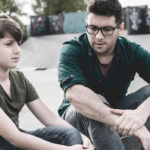Unwrapping myths for children: How to prepare them for the truth about Santa Claus and other legends

Virginia might have been told, “Yes, there is a Santa Claus” — but someday your child will expect an honest answer about the legitimacy of a bearded, centuries-old deliverer of gifts.
This holiday season isn’t just a time for families to come together and celebrate traditions. It’s also a time for children of a certain age to start wondering if the fairy tales and myths they have earnestly believed are actually real.
As painful as it might be to see your child lose the innocence of the holiday, your response can help them advance to the next stage of emotional growth. Or you could let them continue believing in Santa Claus and other legends, if that’s what seems best for them.
Crafting an appropriate response will depend on your child’s developmental level, according to Elisa Bronfman, PhD, a senior staff psychologist in the Hale Family Center for Families and Cardiac Neurodevelopmental Program at Boston Children’s Hospital. That’s why it’s important to have productive conversations with your child. As you talk, pose open-ended questions that allow them to best articulate their beliefs and doubts. From there, you can respond in a way that supports their emotional development and, sometimes, their wish to believe a little longer.
Legends are what we make them
The height of belief in myths such as the Tooth Fairy and Easter Bunny typically happens when children are between the ages of 4 and 8. Parents will want to help construct those stories “in a fun and magical way,” Bronfman says. Usually between the ages of 8 and 10, children start questioning the logic of these myths. “Some of it is a reflection of what their peers are saying, but it’s also because they are thinking about the many Santa Clauses at different department stores and how one person could possibly travel the world in one day.”
How parents handle the reality behind mythical traditions sometimes depends on how they experienced them as children. If you enjoyed Easter egg hunting as a child, then you may want to replicate the fun of the holiday with your own child, Bronfman says. However, when it’s time to get serious about the Easter Bunny, the conversation should consider what’s best for your child in making that discovery, and not how you learned what’s behind the magic.
“Parents will think about their own experiences, and maybe learning the truth behind the myths was difficult,” she says. “But they should remember, this time they can make a positive experience for their own child.”
The truth matters when discussing myths
Inevitably, your child will directly or indirectly inquire about the genuineness of mythical traditions and characters. The way your child talks about it should give you enough clues that they’re either not ready for a big reveal or they have, in fact, reached a dividing line and are ready to cross it.
If your child is younger than when most children begin to doubt traditional legends, start your discussion by asking them why they want to know and what they think the story is. This approach provides a window into their thoughts. You can then assess what would be in their best interest. “You could respond, ‘Would you like me to answer the question or is it important for you to still believe?’” Bronfman says.
“If your child wants to know the truth, tell them,” she adds. “That’s the point — if you don’t want to deceive them.” Age matters less than where they are emotionally. Bronfman also suggests putting an end to the theatrical flourishes — touches like reindeers’ hoof marks in the snow — that had provided “proof” of the characters’ existence. Some children might feel as if they’ve been lied to when learning these characters don’t exist, especially when parents have engaged in elaborate schemes to continue the belief or have used the legends to demand good behavior. Keeping the myths fun and telling the truth when your child is ready reduces this risk.
It also may be easier for your child to accept the loss of mythical figures if holidays have been developed in other meaningful ways. For example, if during Christmas you also place an emphasis on traditions such as baking, caroling, tree decorating, and family gatherings, then your child’s new understanding of Santa Claus will likely be less significant.
One chapter closes, another opens
If you have other children and they are younger, Bronfman recommends including your now-wise-to-the-world child in the fun of keeping myths alive for their siblings who still believe. Help them recognize it’s important to let others have that experience.
“Parents can feel sorrow about the loss of innocence in a child,” she says. But instead of mourning the end of one part of your child’s life, embrace the next stage. “Shift to accepting that your child is using logic and gaining an understanding of the adult world. Appreciate the gains rather than the losses. Growing up is also a magical and wondrous event.”
Learn more about the services available to you and your child at the Department of Psychiatry and Behavioral Sciences.
Related Posts :
-

Developmental milestone checklists don't always agree, finds study
Developmental milestones, such as sitting unsupported or babbling, are a cornerstone for tracking a child’s development and spotting potential ...
-

Pass the pie and a mask: COVID-19 safety tips for the holidays
This holiday season will seem different than the last one — but it’s still not the season to blissfully ignore ...
-

Behavioral health: What parents should know
Even before a worldwide pandemic uprooted life as we knew it, our children have been grappling with an unprecedented health ...
-

Cavities are no trick: How to balance Halloween candy with healthy teeth
Believe it or not, dentists don’t dislike Halloween. They don’t secretly wish for kids to not eat candy. ...





